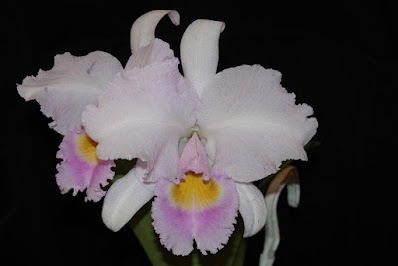Cattleya schroederae - Easter orchid flowers are sweetly fragrant, pale rose to pink or light purple suffused with white with a wavy margin...
Cattleya schroederae, also called as Easter orchid, Baroness Schroeder's Cattleya, Cattleya schroederae var. alba, Cattleya schroederae f. alba, is a species of the genus Cattleya. This species was described by Henry Frederick Conrad Sander in 1888.
DESCRIPTION OF CATTLEYA SCHROEDERAE - EASTER ORCHID
Cattleya schroederae is native to Northeastern Colombia. It is found growing in forests in the eastern mountains from San Martin plains to Cazanare in Colombia at elevations of 500-1600 meters above sea level.
It is a medium sized hot to cool growing epiphyte with narrowly clavate, grooved, green-yellow pseudobulbs. The single leaf is apical, oblong to elliptic-oblong, rounded and notched apically. It is similar to Cattleya trianaei, but lacks the club-like pseudobulbs of the latter.
Easter orchid blooms in spring from the short, erect, few flowered inflorescence that held close to mid-leaf. The flowers are sweetly fragrant, 22.5 cm in diameter, pale rose to pink or light purple suffused with white with a wavy margin. Lips and petals are frilly. There are several white or near-white cultivars available. The lip has yellow and deep rose markings. Flowers are not of heavy substance but are attractive and last up to five week.
CATTLEYA SCHROEDERAE - EASTER ORCHID CARE AND CULTURE
Cultural information should only be used as a guide, and should be to be adapted to suit you. Your physical location; where you grow your plants, how much time you have to devote to their care, and many other factors, will need to be taken into account. Only then can you decide on the cultural methods that best suit you and your plants.
Light:
Cattleya schroederae needs a light level of 25000-35000 lux. Strong air movement should be ensured all the time, especially during flowering. In winter the light level should be the highest. If plants were previously grown in shadier conditions, the light level should be increased gradually. Rapid change can lead to very serious damage to the plant, and even to complete destruction by the sun. During growth periods, the leaves should have a medium green colour as this will indicate correct light levels.
Temperature:
In summer, the average day temperature is 25-28 °C, and the average night temperature is 15-18 °C, with a daily amplitude of 9-11 ° C. In winter, the average day temperature is 24-26 °C, and the average night temperature is 14-17 °C, with a daily amplitude of 9-11 ° C.
Humidity:
Easter orchid needs the average humidity of 70-80% for most of the year, drop to 50-60% in winter. A light misting can be applied at morning and night to help to provide humidity if required when watering is not taking place. The plant like higher night time humidity, with lower daytime levels. Attention must be paid that too high humidity will spoil the flowers.
Substrate, growing media and repotting:
Cattleya schroederae are usually grown in pots or baskets filled with a very thick, loose, quick-drying medium that allows the roots to dry quickly after watering. Rather smaller pots sufficient for 1-2 years of growth are recommended, because the substrate in larger pots remains wet after watering for too long. Rotting may be the result of insufficiently quick drying of the roots. Most growers recommend thick bark, though others prefer pieces of cork mixed with large lumps of charcoal.
Repotting or dividing the plants should be done only when the growth of new roots begins. This will allow the plant to take root in the shortest possible time and avoid weakness. If violated at the wrong time, many plant will stagnate and eventually perish. For the first few weeks after re-potting plants should be keep dryer than usual to help protect the roots, the exception is if there are new live root tips, the plant must be grown as normal. A light misting can be applied after re-potting to help the plants along. Broken roots will rot in the pot, so preventive trimming of any broken roots are strongly recommended.
The plant can also grow well mounted on rootstocks made of cork, tree fern or uneven bark, with high humidity ensured and watering at least once a day in the growing season. In the summer during hot, dry weather, it may be necessary to water several times a day.
Watering:
Easter orchid should be abundantly watered during active growth, but the roots must always dry quickly after watering. This can easily be seen, especially in clear pots by checking the root colour. Greenish or slightly translucent means the roots are still wet, and white roots are dry. When new growths reach maturity in the autumn, the amount of water should be reduced. The flower buds are susceptible to fungal infections if the plant is kept too wet before flowering.
Fertilizer:
The plants should be fertilized every week 1/4-1/2 of the recommended dose of fertilizer for orchids. A fertilizer with a high nitrogen content is beneficial from spring to mid-summer, and a fertilizer richer in phosphorus should be used in late summer and autumn.
Rest period:
Cattleya schroederae should be given a drier rest as new growths mature. In winter, when not in active growth, the plant need less water but should not be dry for long periods. Fertilization should be reduced until watering is increased in spring, especially for plants grown in the darker, short-day conditions typical of higher latitudes.















COMMENTS